5 Best Kanban Apps in 2025: Organize Your Teams & Projects to Increase Productivity
A kanban board is usually the heart and soul of a project management tool. Kanban boards visualize workloads, track team members and can be used to manage complex projects. Here, we’ll look at five of the best kanban apps around.
If you’ve ever been involved in a project, chances are you’ve encountered a kanban board. This easy-to-use project management tool is popular thanks to its drag-and-drop mechanisms and because it can provide at-a-glance updates regarding tasks and team members. Still, choosing which kanban tool to use can be tricky, so let our team of project management experts show you a few kanban apps you can try.
What is a kanban board? In its basic form, a kanban board contains columns and task cards that allow project managers to visualize projects as they move through job stages. You update tasks by dragging and dropping cards into various columns that indicate completion stages. When a card moves from the board’s left to the board’s end at the right, the task is complete.
In this guide, you learn about the best kanban apps, and we’ll reveal our top five picks for kanban software. All five of the kanban tools listed here are fantastic, as they all offer features that will appeal to everyone who loves kanban methodology and the drag-and-drop approach to working.
There are, of course, many different types of project management software you can use. If you’re not sure kanban is for you and you’d like to see a wide variety of tools — from the kanban method, to Gantt charts, to scrum — check out our best project management software roundup. We’ve tested dozens of project management tools, so we’re confident you’ll find something to your taste.
-
01/25/2023 Facts checked
Rewrote the article; updated to follow a more clear format.
-
09/25/2023 Facts checked
Removed reference to discontinued ClickUp Business Plus plan.
The Top Kanban Apps for Project Management
- 1
- 2$10 / month(All Plans)
- 3
- 4
- 5
What Makes the Best Kanban App?
We ran a serious of rigorous tests before choosing the best kanban app. One of the first things we look at when choosing the best kanban project software is whether or not the kanban project management tool has a good free plan in addition to strong paid tiers. We also look at how easy the software is to use, aesthetics, integrations, communication tools, process automation and more.
After testing dozens of kanban apps, we came up with our rankings. The best kanban board apps are Trello, Wrike, monday.com, Asana and ClickUp, all of which offer excellent kanban boards, while being super easy to use, and most of them come with generous free plans.
While all of the tools in this kanban project management tool list are great, in our expert opinion, Trello still reigns supreme, thanks to its stellar feature set and the fact that it’s free to use. Wrike is a close second, thanks to its simplicity and focus on function, while monday.com comes in third, boasting a gorgeous user interface and powerful tools. Asana and ClickUp round out the group, as they also have a lot to offer.
The 5 Best Kanban Apps
Now that you’ve seen which kanban board apps we’ll focus on and why we have chosen them, we’ll break each platform down further. All the listed kanban boards deserve to make our best kanban apps list; below, you’ll see why. We’ll start with Trello, which is also our best kanban app for personal use.
1. Trello
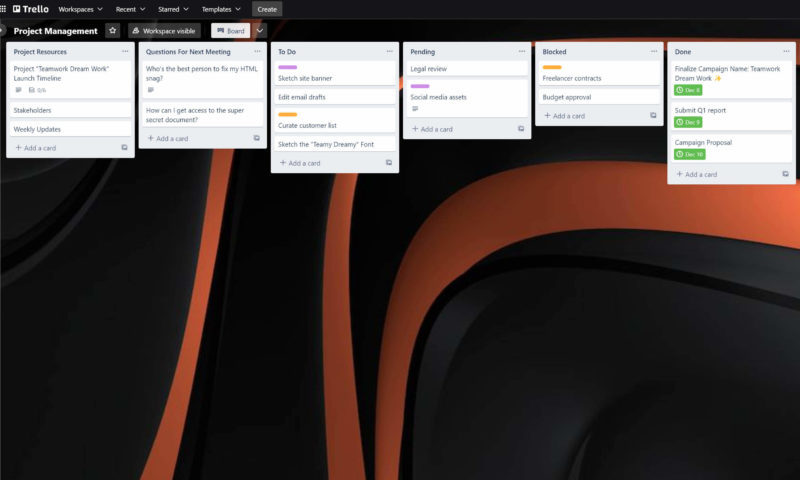
More Details About Trello:
- Pricing: Free, $5 per month (one-year plan) per user
- Provider website: trello.com
Pros:
- A robust free tier
- Excellent integrations
- User-friendly interface
Cons:
- Your data isn’t private
- Paid tiers are weak
If you’re looking for a feature-packed, easy-to-use, free kanban board, Trello could be for you. We have used Trello at Cloudwards for years, and it has done everything we’ve asked of it. The web and mobile application versions of Trello are user-friendly, boards offer excellent at-a-glance overviews, integrations are solid and the core features will cost you nothing.
Trello has paid tiers, too. Trello’s standard plan offers unlimited boards and 1,000 automations instead of 250 automations in the free plan. The premium plan offers unlimited automations and boards, access to a timeline, a graph view and a calendar. While good, the paid tiers don’t offer good value compared to the competition. You can read more about pricing in our Trello review. Also, make sure to read our Trello vs Wrike article.
Another downside to Trello is that your data isn’t private. Atlassian does state in its privacy policy that they track how the kanban board tools are used and that they share information with third parties for targeted advertisements. However, it’s a small price to pay when the free tier of Trello is so good.
Integrations and Power-ups Make Trello Shine
What really makes Trello stand out from the crowd are integrations and power-ups. You can use an unlimited amount on the free plan. There are many integrations — free and paid — that can help make project management a cinch, such as integrations with Slack, Google Drive, MailChimp, Outlook and more (we use these daily).
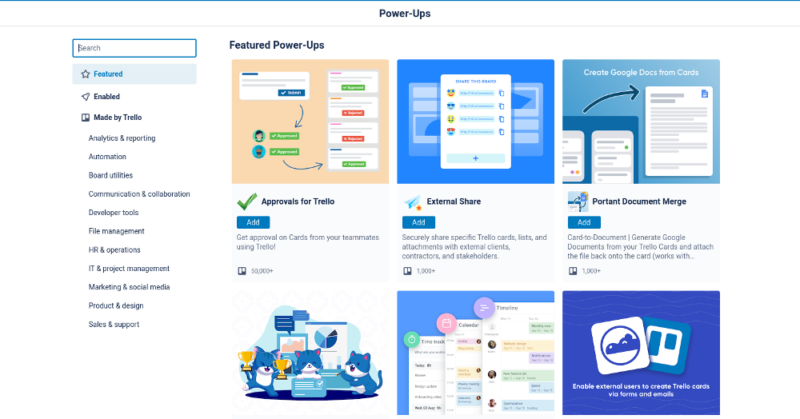
Trello is still the best kanban app, as well as the best kanban app for personal use. The feature set, ease of use and the price of $0 make it hard to beat. Trello does offer a couple of paid tiers. The Standard tier is $6 per month per user, while the Premium tier costs $12.50 per user per month. An Enterprise tier, which offers advanced admin and security settings, costs $17.50 per month. It’s hard to go wrong with Trello. Have a look at how to use Trello for project management and how to integrate Trello and Jira.
- Unlimited users, 10 boards, Unlimited power-ups, Unlimited storage
- Price is per user, Unlimited boards, Custom fields, Invite guests
- Price is per user, Several new views
- Price is per user, Advanced admin & security settings
2. Wrike
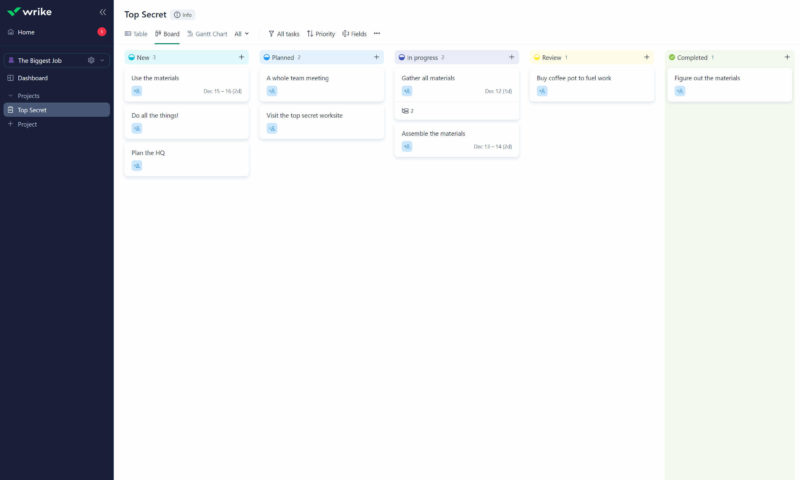
More Details About Wrike:
- Pricing: Free, $10 per month (one-month plan) per user
- Provider website: wrike.com
Pros:
- Very easy to use
- A solid free plan
- Robust security features
Cons:
- Bland aesthetics
- Shady privacy policy
Wrike comes in second on our list of best kanban apps. Unfortunately, Wrike is the ugly duckling out of the five kanban apps we showcase here, but from the standpoint of functionality, Wrike is up there with the best of them. The Wrike free plan offers a good feature set that provides a few integrations, large task cards, multiple views, access to mobile apps and 2GB of storage.
Move up to the Team plan, and you get more integrations, access for up to 25 users, 50 automations, support for multiple projects, Gantt charts and more. The Business plan is where Wrike really shines, with time-tracking, calendars, advanced admin options, more reports, integrations and automations, 5GB of storage and support for up to 200 users.
In our testing, we found that Wrike is a joy to use, no matter what tier you opt for, thanks to spacious work areas and great features. However, Wrike’s privacy policy isn’t the best. Overall, security features are strong, but per Wrike’s privacy policy, the company does sell data to third parties for targeted ads. You can find out more about the security and privacy features in our Wrike review.
Views, Glorious Views
The free tier of Wrike comes with a solid kanban board, a table view and a list view. However, as mentioned above, Wrike comes into its own when you jump into the paid tiers. The team plan adds Gantt Charts and subtasks, which help supplement the kanban app, and help with complex projects and project planning.
The Business plan goes even further by offering project blueprints and unlimited dashboards. Wrike is also one of the only project management apps with integrated time-tracking. If you really want to track your projects from every possible angle, and you need more than a simple kanban board, Wrike could be right for you.
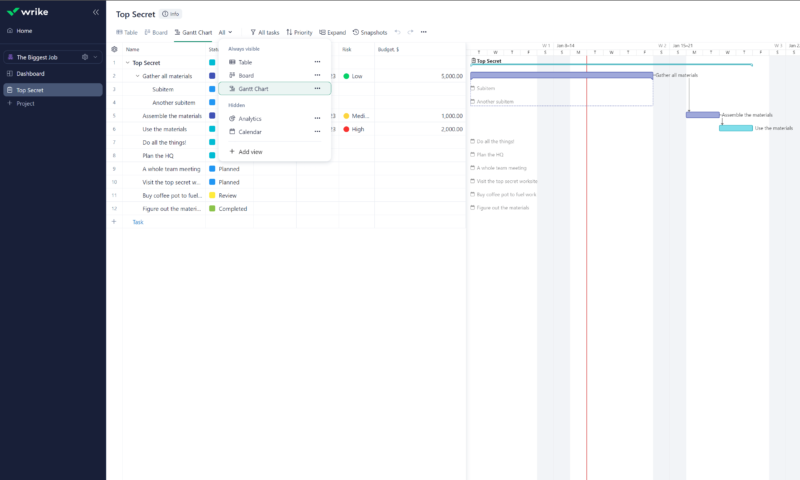
make it a great project management platform.
Wrike is one of the best project management tools you can use. When it comes to implementing the kanban method in your workplace, you’ll be able to do so quickly thanks to the simple user interface, integrations and its ability to help with workflow management in simple and complex projects.
Aside from the free plan, you’ll find a Professional plan that costs $10 per user per month. The Business plan jumps up to $25 per month, and Enterprise and Pinnacle plans can scale to fit your business needs. The pricing between tiers is a little extreme, but with Wrike, you get what you pay for, and you do get a lot. If you value function over form, Wrike is for you.
- Unlimited users. Basic features.
- Price is per user. Plans for 5, 10 and 15 users.
- Price is per user. No monthly option. Plans for 5 to 200 users.
More plans
- For large teams; Enterprise-grade security and scalability; Plans for 5 to an unlimited number of users.
- For teams with complex work needs; Advanced tools and analytics for complex work; 5 to unlimited users
3. monday.com
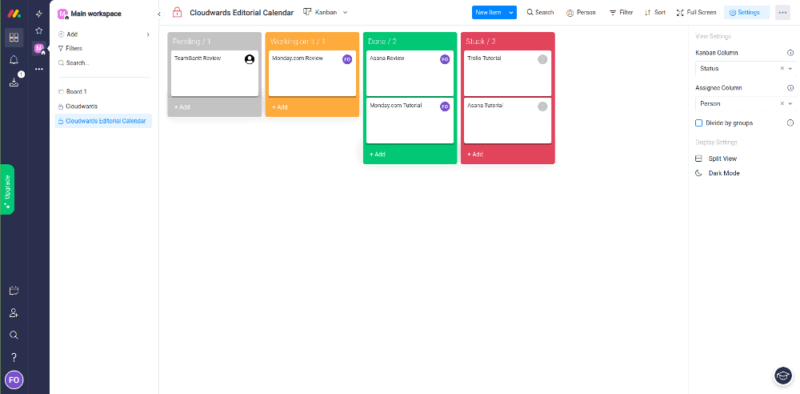
More details about monday.com:
- Pricing: Free, $9 per month (one-year plan) per user
- Provider website: monday.com
Pros:
- Good pricing
- Best-looking kanban tool
- Project management features
Cons:
- Free tier is sad
- Basic tier is lackluster
- Integrations opens at different price points
monday.com is a kanban tool with a colorful palette and strong feature set. The platform is great when you move into the paid tiers. However, monday.com’s free tier could be stronger. It offers only three boards, two team members, 200 templates and two views (list and kanban). The lackluster Basic tier, which introduces unlimited users, is also forgettable.
However, if you’re a power user and want task management software that will blow your socks off, monday.com might appeal to you. Our experts recommend the $14 per user per month Standard plan, which brings monday.com to life with automations, integrations, multiple views, unlimited boards, users and items, and 20GB of storage. The Pro tier takes things up a notch with more of everything.
Overall, monday.com is wonderful to use. The drag-and-drop nature of the kanban method is alive and well, thanks to spacious boards. Task organization is easy, thanks to bold colors and filters. Still, there are downsides. Unfortunately, service integrations open at different tiers, which isn’t ideal. While security is solid, data is hosted on AWS, which has been prone to issues.
The monday.com Dashboard is a Project Manager’s Dream tool
If there’s one feature that makes monday.com stand out from the crowd, it’s the powerful dashboard view. This view is available in the free and Basic tiers, but you can only pull views from one project. However, when you step up to the Standard plan and beyond, you can populate Gantt charts, tables, workloads, calendars and more from multiple projects.
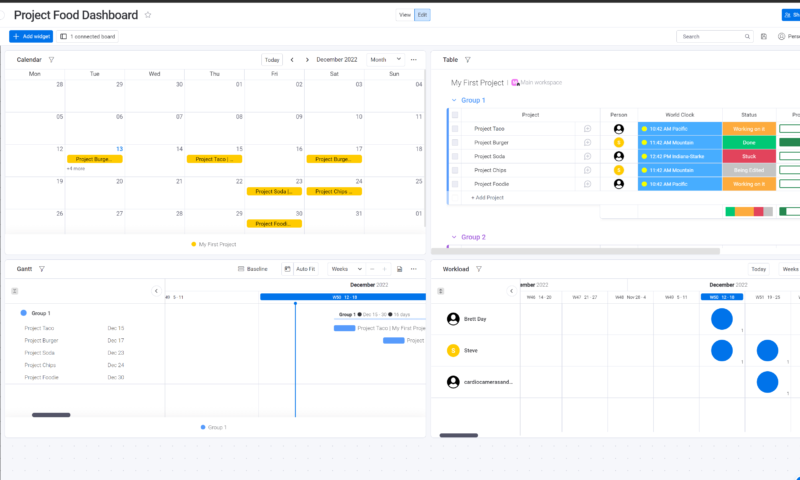
in multiple views from your project.
While the free and $12 per user per month Basic tier of monday make us wish for more, we quickly forget about them and start smiling again when we use the $14 per user per month Standard tier. The Pro tier of monday.com — which costs $24 per month per user — is overkill for most, but it’s a good option if needed. Like other kanban board apps, there’s also a scalable Enterprise plan.
monday.com is a delight to use from the word go, thanks to the simple interface, dashboard and other available tools. If you subscribe to monday.com, you’ll have one of the most flexible kanban boards and task management apps at your disposal; we rank it as the best project management software for a reason. Find out more about this kanban tool in our monday.com review.
- Maximum users: 2
- Minimum users: 3; All prices per user
- Minimum users: 3; All prices per user
More plans
- Minimum users: 3; All prices per user
- Enterprise-level features.
4. Asana
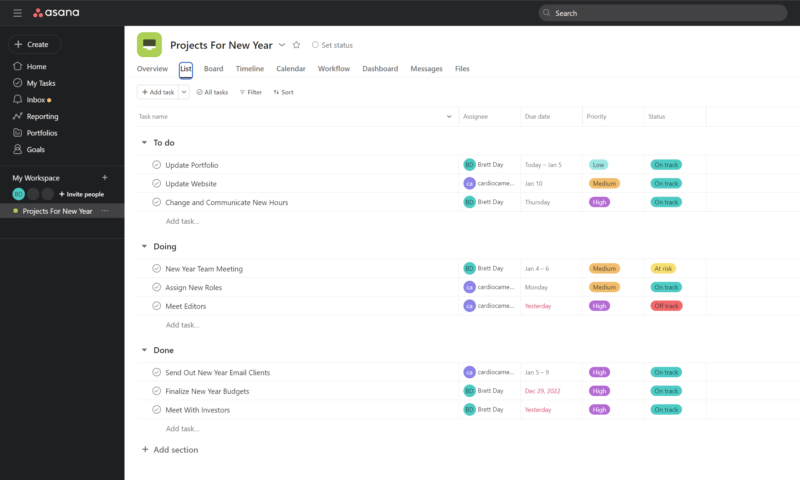
smooth movements and colorful design.
More details about Asana:
- Pricing: Free, $10.99 per month (one-year plan)
- Provider website: asana.com
Pros:
- Excellent free tier
- Many features & integrations
- Colorful user interface
Cons:
- Quite expensive
- Plan progression is not ideal
- Mediocre security
It’s hard to overlook the jack of all trades that is Asana. While Asana doesn’t excel in any one area, its implementation of kanban and its features make it one of the best kanban apps. The Asana free tier is excellent and will likely be enough for many, thanks to features that rival Trello. Check out our Trello vs Asana article, and read more about Asana’s free tier in our Asana review.
Asana’s Premium and Business tiers add key features that make it more potent than monday.com in some areas. You’ll get unlimited users, guests and dashboards. There are custom fields, admin consoles, premium integrations, and goals and milestones. However, our experts believe that the wild pricing (which we’ll cover later) makes Asana a little less desirable.
From a user-friendliness perspective, Asana rivals monday.com and Trello, and outshines Wrike. However, when it comes to security and privacy, things could be better. Per Asana’s privacy policy, free users have data siphoned, but the data is not sold. Security-wise, Asana uses AWS, which makes us uncomfortable due to previous security issues.
Unlimited Integrations
Integrations make kanban boards work for you. Fortunately, you can make Asana do a lot of the heavy lifting thanks to the unlimited use of integrations. There are over 100 integrations — or apps, as Asana calls them — available in the free and Premium tiers. Only a few, like Salesforce and Adobe’s Creative Cloud, are locked behind the business tier paywall.
You’ll find everything from Google Calendar to Microsoft Teams and Slack to Google Workspace within Asana. You’ll even find integrations that help with time tracking, file sharing, communication, sales, operations and more. Unlimited integrations are a key feature of Asana, and it’s what helps the platform cement itself in our list of best kanban apps.
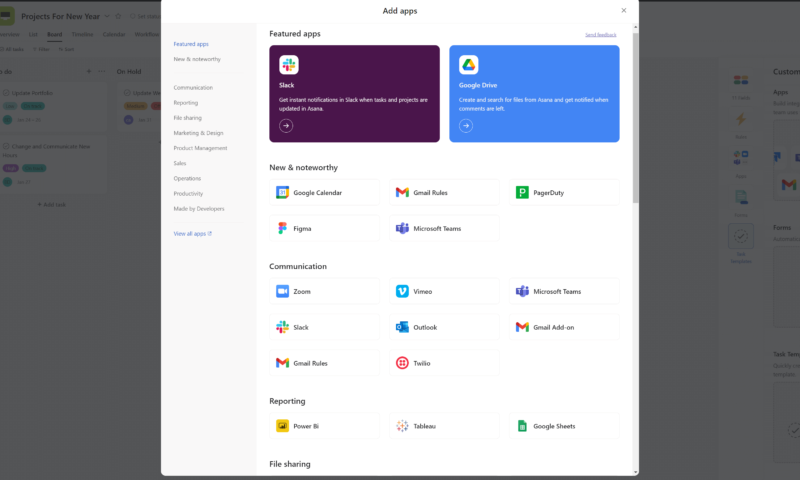
and there’s no limit on how many you can use.
Our hands-on testing revealed that Asana is a quality kanban app. The slick interface and the long list of features make it a favorite of ours. We just wish the Premium and Business tiers were priced more competitively. The premium plan costs $13.49 per month per user, while the Business tier jumps to an eye-watering $30.49 per user per month. There’s a customizable Enterprise plan, too.
Asana’s versatility is what makes it shine. The kanban tool and kanban features on offer are solid, and so are all the other views and tools. If you can make do with the free tier, we highly recommend Asana. However, if you need the more advanced features, which are locked behind lofty paywalls, you might be better off looking at other project management software.
- Up to 10 users
- Price is per user. unlimited users, expanded features
- Price is per user. unlimited users, even more features
- Custom pricing, advanced security features
5. ClickUp
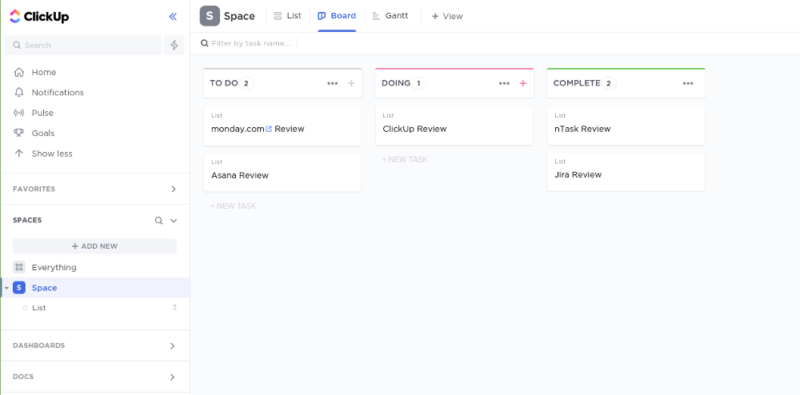
More details about ClickUp:
- Pricing: Free, $7 per month (one-year plan) per user
- Provider website: clickup.com
Pros:
- A good free plan
- Competitive pricing
- Long list of features
Cons:
- Steep learning curve
ClickUp appeals to many thanks to its low pricing and long feature list. While basic in design, our tests showed that ClickUp is a powerful tool with a free tier featuring core tools, including unlimited tasks and members, time tracking and a team chat app. ClickUp is unique in that premium tools are in the free tier, but can only be used a limited number of times per month.
As with other project management apps, ClickUp offers three paid tiers that extend functionality or remove the limits on the high-tier tools, and add new features that can help you with work management. You’ll find integrations for many mainstream applications, including Slack, Discord and Microsoft Teams.
There are also “Click Apps” that help create custom workflows.
As a kanban app, ClickUp works well. While the interface isn’t pretty, performance is quality once you find your way around. Regarding privacy, ClickUp’s privacy policy states it never sells data. Security-wise, ClickUp stores data with AWS, which is not the best. Overall, though, this kanban app is terrific. Please read our ClickUp review to find out more.
Unique Tools Make ClickUp Powerful
As a kanban board app, ClickUp has plenty to offer, and beginners and old hats alike will appreciate what it can do. When we tested the software, we discovered that ClickUp has a few tricks up its sleeve that help elevate it into one of the best pieces of visual management software currently available. One such tool is the Mind Map.
The Mind Map allows you to brainstorm your ideas and projects. You can add tasks and subtasks, much like a Gantt Chart, and can then import the Mind Map straight into a kanban board. Other tools, such as timelines, calendars and maps, all add to the package and make ClickUp an attractive option.
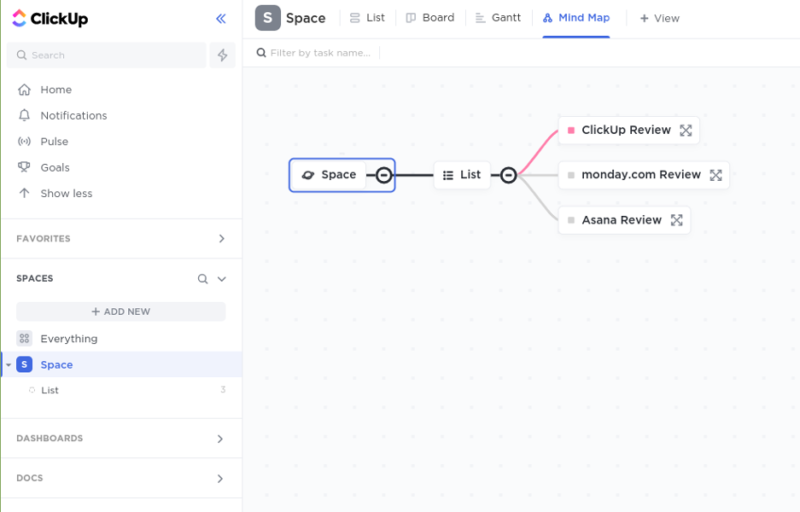
Despite not being the easiest on the eyes and having a unique take on how feature sets are implemented across tiers, ClickUp remains a great task management platform. Spend time with the interface and you’ll be whipping up kanban boards in no time. The ClickUp free tier offers plenty and is a good option for individuals.
The $10 per user per month Unlimited plan removes many tool limitations, while the $19 per user per month Business plan adds many admin features and automations. If you’re looking for a work management platform that’s slick and easy to use, give ClickUp a try.
- Basic functionality with some limitations
- All prices per user
- All prices per user
Final Thoughts: Best Kanban Tools
As you can see from our list of the best kanban tools, there are options available to suit all kinds of people and businesses. Whether you’re looking for a kanban app that integrates time tracking, or one that offers unlimited integrations and communication tools, the apps above have you covered. They’re all well-designed and pleasant to use, and it’s hard to go wrong with any of them.
However, we still believe that Trello is the epitome of kanban and kanban methodology thanks to its user-friendly interface, fully featured free tier and unlimited integrations. However, that’s not to say that Wrike, monday.com, Asana and ClickUp aren’t stellar options. All of these kanban boards will help you manage your projects and teams with ease.
Interested in learning more? Have a look at our cheap project management software article, as well as the best project management software for multiple projects.
Have you used any of the kanban apps we’ve mentioned above? If so, which platforms have you used and what’s your favorite feature? Perhaps you have different options you’d like to share with others. Please let us all know by using the comment section, and thank you for reading.
FAQ
There’s no one-size-fits-all answer to this question. Everyone has different opinions regarding what makes the best kanban tools. However, we believe Trello is the best kanban software. Trello makes it easy to manage projects, and it’s feature-packed and free to use.
Trello, Wrike, monday.com, Asana and ClickUp all use kanban boards. Others such as Notion, Jira and nTask also offer great kanban boards.
Unfortunately, Google does not offer a kanban tool.
If you use Microsoft Teams, you’re in luck. There’s a plug-in that can integrate a kanban board.


